Jul 1, 2017 | Canada, celebration, coins

Canada Day, or Fête du Canada in the French-speaking areas, is Canada’s version of Independence Day. It celebrates the enactment of their Constitution on July 1, 1867. The Constitution Act of 1867 brought together Ontario, Quebec, Nova Scotia, and New Brunswick to create the Dominion of Canada. As a Dominion then an independent member of the Commonwealth Realm, Canadian history is a bit different from that of the United States but as interesting.
This year, Canada celebrates its 150th Anniversary. Joining in the celebration, the Royal Canadian Mint has been issuing many collector coins with various themes for collectors to celebrate. One of the most talked about coins is the circulating $2 coin called “Dance of the Spirits” that features the Northern Lights that glow in the dark.
-
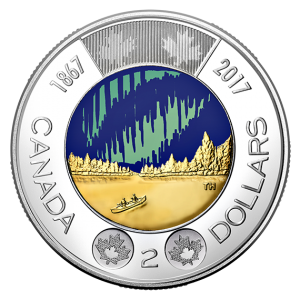
-
Reverse design of the 2017 Canada $2 “Dance of the Spirits” circulating coin
-
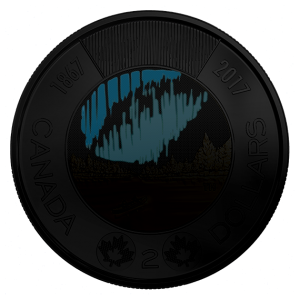
-
What the 2017 Canada $2 “Dance of the Spirits” reverse would look like in the dark
Collectors can purchase a 5-coin set of uncirculated Canada 150 circulation strike coins in a special folder from the Royal Canadian Mint for $19.95 CAD (currently $15.39 USD). For those who want the full set of uncirculated coins, the complete 12-coin set is available for $34.95 CAD ($26.95 USD).
-
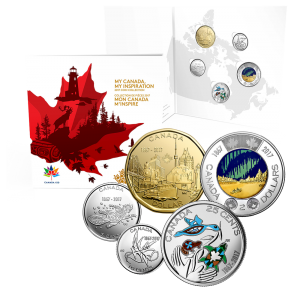
-
2017 Canada 150 5-Coin Collection
-
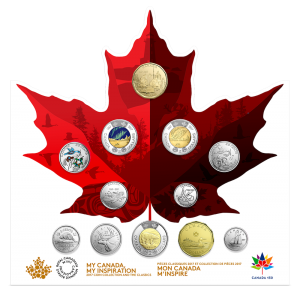
-
2017 Canada 150 Circulation 12-Coin Collection
If you can wait, the Royal Canadian Mint is scheduled to attend the World’s Fair of Money. Sometimes they offer discounts to those attending the show and they could be sold out of these sets! But if you are not going to make it to Denver, the Royal Canadian Mint is very good with shipping to the United States.
HAPPY CANADA DAY!
From your friends in the United States
May 29, 2017 | celebration, commemorative
A man may die, nations may rise and fall, but an idea lives on.
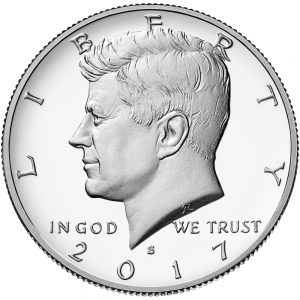 John Fitzgerald Kennedy was the second son of Joe and Rose Kennedy. Born on May 29, 1917 in Brookline, Massachusetts, Jack, as he was known to family and friends, was born of privilege and lead that life being able to travel the world in his younger days. It also helped that his father was named Ambassador to the Court of St. James (London).
John Fitzgerald Kennedy was the second son of Joe and Rose Kennedy. Born on May 29, 1917 in Brookline, Massachusetts, Jack, as he was known to family and friends, was born of privilege and lead that life being able to travel the world in his younger days. It also helped that his father was named Ambassador to the Court of St. James (London).
The goal of education is the advancement of knowledge and the dissemination of truth.
He used his experience to better understand the plight of people and majored in government at Harvard College. For his honors thesis, Kennedy toured the Soviet Union, the Balkans, and the Middle East to research different political philosophies. He later was in Germany when the German Army invaded Poland marking the beginning of World War II. With his father still in London, they attended the House of Commons supporting the declaration of war on Germany.
My fellow Americans, ask not what your country can do for you, ask what you can do for your country.
On his return to the United States, Kennedy tried to enter the Army’s Officer Candidate School but was medically ineligible because of chronic lower back problems. He used his family’s connections to join the U.S. Naval Reserves. During World War II, he famously commanded PT-109.
Leadership and learning are indispensable to each other.
Following the death of his elder brother in 1944, Kennedy was tapped by his father to run for office. Kennedy won his first election in 1946 to serve two terms in the House. In 1952, Kennedy ran for the Senate against three-term incumbent Henry Cabot Lodge Jr. The popularity of Dwight Eisenhower running for the president did not help Lodge as Kennedy was able to win by 70,000 votes.
Let us not seek the Republican answer or the Democratic answer, but the right answer. Let us not seek to fix the blame for the past. Let us accept our own responsibility for the future.
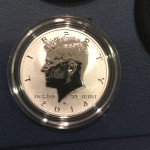
2014-W Reverse proof in the 50th Anniversary Kennedy Half-Dollar Silver Set
I am not the Catholic candidate for president. I am the Democratic Party candidate for president who also happens to be a Catholic. I do not speak for my Church on public matters – and the Church does not speak for me.
While trying to overcome the “Catholic question,” Kennedy his opponent, Richard Nixon, held three debates. Although not much is said about the last two debates, the first one was historic. Kennedy used makeup and appeared cool and presidential. Nixon looked nervous, sweaty, and his five o’clock shadow did not help. When the debate was over, those watching on television thought Kennedy won while those listening on radio thought Nixon won. It was a fascinating use of new media and set the tone for presidential races to come.
If we cannot now end our differences, at least we can help make the world safe for diversity.
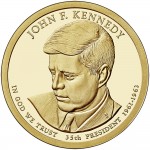 Kennedy won the 1960 election by two-tenths of the popular vote and exceeded the Electoral College by a 303-219 margin even though 14 electors from Alabama and Mississippi refused to support him because of his stance on civil rights. Kennedy became the youngest person ever elected president.
Kennedy won the 1960 election by two-tenths of the popular vote and exceeded the Electoral College by a 303-219 margin even though 14 electors from Alabama and Mississippi refused to support him because of his stance on civil rights. Kennedy became the youngest person ever elected president.
We choose to go to the moon. We choose to go to the moon in this decade and do the other things, not because they are easy, but because they are hard, because that goal will serve to organize and measure the best of our energies and skills, because that challenge is one that we are willing to accept, one we are unwilling to postpone, and one which we intend to win, and the others, too.
 There were a lot of accomplishments and difficulties during the term of the 35th president that there are too many to highlight here. But one that is significant in the current numismatic world was the speech he made at Rice University in support of the space program. At the time Kennedy was pushing for the funding to enter the space race, Congress was skeptical over spending the money. His impassioned speech to the students at Rice as well as several others around the nation helped gain public support. Congress eventually funded the space program.
There were a lot of accomplishments and difficulties during the term of the 35th president that there are too many to highlight here. But one that is significant in the current numismatic world was the speech he made at Rice University in support of the space program. At the time Kennedy was pushing for the funding to enter the space race, Congress was skeptical over spending the money. His impassioned speech to the students at Rice as well as several others around the nation helped gain public support. Congress eventually funded the space program.
In 2019, we will be celebrating the 50th anniversary of making it to the moon by the end of that decade with the Apollo 11 Commemorative Coin program. Phase One of the competition ends on June 29, 2017, or until 1,000 entries are received. Visit the U.S. Mint’s competition page for more information.
Would the United States have made it to the moon by the end of the 1960s and beaten the Russians there without Kennedy? We may not be able to answer that question but we do know he set the policies that will allow for the celebration in two years.
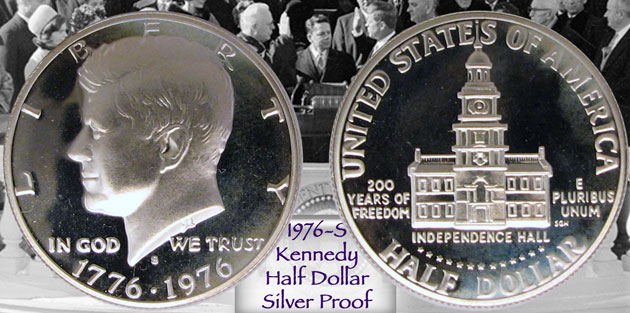
Happy 100th Birthday to President John F. Kennedy.
Credits
- 2017 Kennedy Half Dollar and 2015 Kennedy Dollar images courtesy of the U.S. Mint.
- All other images are property of the author.
May 29, 2017 | celebration, commemorative
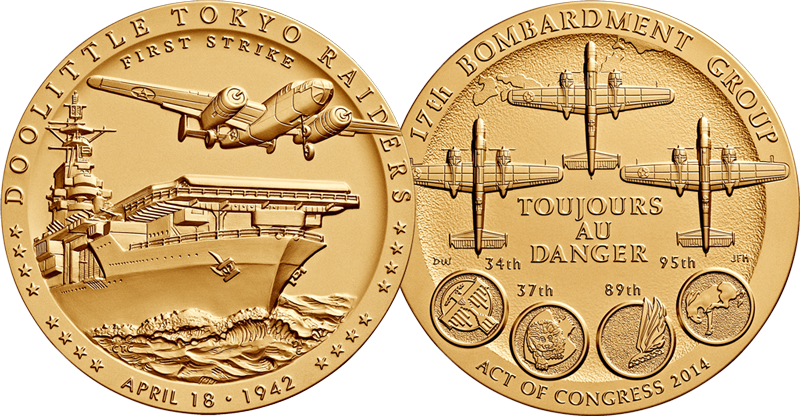
The last surviving member of Doolittle’s Raiders is Lt. Col. Richard Cole, Doolittle’s co-pilot. Cole is now 101 years old. Click here to read about Cole and Doolittle’s Raid on Japan that helped the U.S. launch the War in the Pacific.
Southern states began their own commemoration to honor their soldiers who died during the war. No specific date was used but occurred in late April through June. By 1880, there was a more organized Confederate Memorial Day. These celebrations honored specific soldiers to commemorate the Confederate “Lost Cause.” By 1913, a sense of nationalism saw a commemoration of all soldiers that have died in battle.

1995-S Civil War Battlefields Commemorative Silver Dollar
Memorial Day is the national remembrance of those who made the ultimate sacrifice for this country. Please take a moment and honor the memories of those who have died for without them who knows where we would be today.
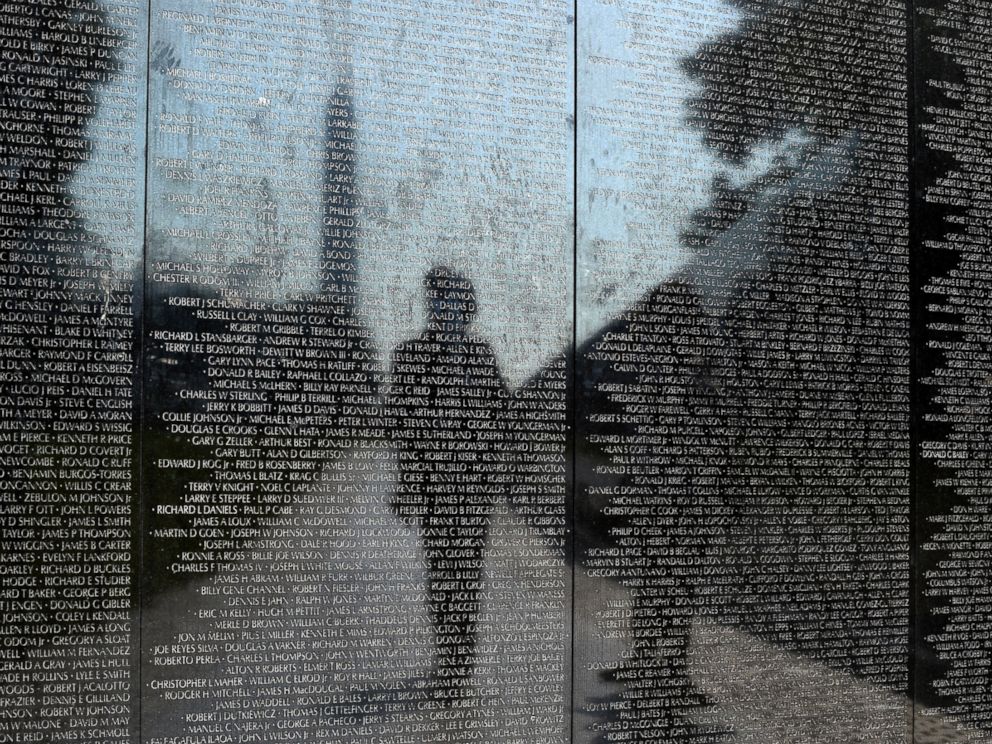
Visitors are reflected in the Vietnam Memorial in Washington, May 27, 2016. (Susan Walsh/AP Photo via ABC News)
Credits
- Medal image courtesy of the U.S. Mint.
- Vietnam Memorial Image by Susan Walsh/AP Photo via ABC News.
Mar 17, 2017 | BEP, Britain, celebration, coins, education

2016 Canada Lucky Four-Leaf Clover 1 oz Silver Coin
Patrick was not welcomed when he arrived but worked with the society to convert them to Christianity. Although most of his writings portrayed that he was probably more successful than he was, but after working with the people, first in the northern regions of Ireland, he did find success. He once wrote that he baptized thousands of people and some have written that he baptized hundreds on a single day. Using the native three-leaf shamrock to describe the Holy Trinity, Patrick was promoted bishop and apostle of Ireland. He died on March 17, 461 in Saul, where he founded his first church.
For thousands of years, the Irish have observed the day of Saint Patrick’s death as a religious holiday, attending church in the morning and celebrating with food and drink in the afternoon. The first St. Patrick’s Day parade was celebrated in 1762 when Irish soldiers serving in the English military marched through New York City.
With Saint Patrick’s Day, talk about “the luck of the Irish” and associate the shamrock of four-leaf clover as a lucky symbol. I was thinking if there are coins or currency that would bring you luck. After searching around online for lucky coins there was a common theme: something that is special to you. Here is a composite of the types of lucky coins:
- Coins from the year of your birth: I have helped several people buy proof and mint sets of coins from the year they were born. On one of my father’s milestone birthdays, I bought uncirculated coins from the year of his birth and had them slabbed in an NGC multi-coin holder when they were still being offered.
- Coins from a country special to you: On one of my wife’s milestone birthdays, I purchased a Canadian proof set from the year of her birth. Although she was born in the United States, her parents were from Canada and it has become a special collectible.
- Coins that have a special meaning: A friend keeps a Morgan Dollar in his top desk drawer. The desk used to belong to his grandfather who kept that coin as his “emergency dollar” during the Great Depression.
- Coins found during a happy or coincidental time: A client once showed me a 1958 Cuban peso that he found on the street in Miami that he keeps as a pocket piece. He decided that since it was the same year his family fled Cuba, it was a fortuitous find.
- Coins of a specific design: Sometimes the design may be added to the coin. I once met someone who had several Love Tokens from his relatives he says it is his family’s way of watching over him.
A silver sixpence in her shoe

1962 British Sixpence
Feng Shui

Feng Shui Coins
The number of coins tied together is important. One coin is believed to promote loneliness and will leave you empty. Two is better but does not have the power of rebirth that three does. Three coins tied together represents the heavens, earth, and mankind. Four represents death and not something that would promote Feng Shui. The Chinese do not know why five is not lucky but this is accepted. While three is considered proper Feng Shui, making it more powerful would be three-times-three, or nine, coins.
For luck, you can hang Feng Shui coins on the on the inside of your front door, not the outside. You want the luck inside. Do not hang your Feng Shui coins on your back door because it will luck to leave your house.
You can place three Feng Shui coins on top of items to bring them luck. When you do this, it is important to place the Yang side facing up to invite the luck to protect your item. The Yang side is the side with the four characters.
When giving a gift, attach three Feng Shui coins to the package to bring double happiness. It tells the recipient that with the gift you are also wishing them wealth, prosperity, and happiness. Doing this will add to your Feng Shui for giving generous and unselfish wishes.
Numerology and currency
Numerology is the belief in the divine or mystical relationship between numbers and the physical world. Many people practice a mild form of numerology called a “lucky number.” For those who believe in some type of numerology can turn to the serial number of currency to add to their collection.
One of the more expensive aspects of notaphily is the collection of patterns numbers. Typical patterns are as follows:
- Solid: every digit the same
- Ladder: numbers that count up, like 12345678, or down, like 98765432
- Low or High numbers
- Radar numbers: when the serial number repeats forward and backward, like 12344321
- Repeater numbers: when the serial number is repeated, like 12341234
- Super Repeater: pairs of numbers that repeat four times, like 36363636
- Double Quad: two pairs of four numbers, like 88889999
- Seven of a kind: both in a row or seven of the same number
Notes that represent dates can bring luck such as one that has your birthdate. For someone born on March 17, 1977, finding a note with the serial number 03171977 or even 19770317 could be very lucky. Since the numbers reset for every series and there are 12 Federal Reserve branches used as a prefix, you have quite a few chances of finding these.

$1 Lucky 777 Note
The BEP also sells lucky money that includes the Lucky 7 set. These notes have a serial number that begins with three 7s. You can also buy notes in special Chinese holders with serial numbers that begin with “8888” and “168.” In Chinese, the “eight” sounds similar to the word for “prosper” or “wealth.” Selling the Lucky 8888 note is to help promote prosperity and wealth.
The “168 Prosperity Forever” note plays on the Mandarin pronunciation of the number that sounds similar to “prosperity forever.” If the BEP used the Cantonese pronunciation, they would have the use the serial numbers beginning “768.”
Go find your lucky coin and may you have health and prosperity.
Credits
- Canadian coin image courtesy of the Royal Canadian Mint
- Sixpence image courtesy of Wikipedia
- Feng Shui coins image courtesy of eBay user “technology-onsale“
- Lucky 777 Note courtesy of the Bureau of Engraving and Printing
Jan 1, 2017 | celebration, coins, commemorative
Happy New Year!
As we begin a new year, we should look forward to better times for our hobby, our nation, and our world. I wish you and yours a Happy and Healthy 2017 and hope that you find the key coin of your dreams!
-
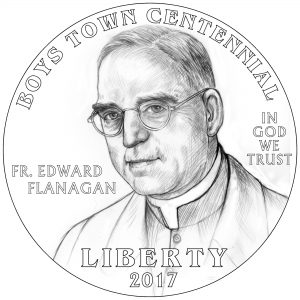
-
Design for the 2017 Boys Town Commemorative $5 Gold Coin Obverse
-
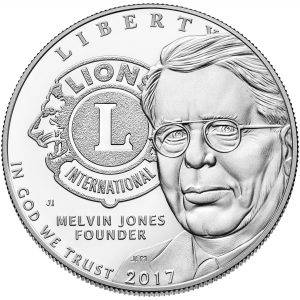
-
2017 Lions Clubs Commemorative Silver Dollar Proof Obverse
Nov 24, 2016 | celebration, coins
All in a Word
By Aileen Fisher
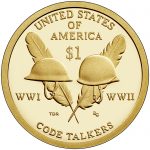 |
T |
for time to be together, turkey, talk and tangy weather |
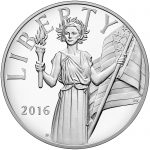 |
| H |
for harvest stored away, home and hearth and holiday |
| A |
for Autumn’s frosty art, and abundance in the heart |
| N |
for neighbors and November, nice things, new things to remember |
| K |
for kitchen, kettle’s croon, kith and kin expected soon |
| S |
for sizzles, sights and sounds, and something special that abounds
|
|
That spells THANKS for joy in living |
|
And a jolly good Thanksgiving. |
Aug 1, 2016 | celebration, legislative, policy, US Mint
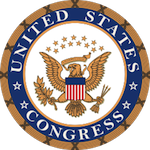 As we do every month, we look back at the previous month’s activity in congress that will affect us numismatically. July started with congress on their 4th of July break coming back for a one week session before leaving to attend their respective conventions.
As we do every month, we look back at the previous month’s activity in congress that will affect us numismatically. July started with congress on their 4th of July break coming back for a one week session before leaving to attend their respective conventions.
Prior to leaving, congressed passed the United States Semiquincentennial Commission Act (Public Law 114-196). The law authorizes the formation of a commission to organize the national celebration of the 250th anniversary of the founding of the United States on July 4, 2026. It was signed by President Obama on July 22, 2016. Section 5, Paragraph (c)(2)(F) of the new law recommends that the commission encourages “Federal agencies to integrate the celebration of the Semiquincentennial into the regular activities and execution of the purpose of the agencies through such activities as the issuance of coins, medals, certificates of recognition, stamps, and the naming of vessels.”
Those of us who are old enough to remember, this was the first time in the modern era that circulating commemoratives were issued. The quarter, half-dollar, and dollar coins all had special reverse designs that were issued in 1975 and 1976. These coins remain popular amongst collectors and an interesting curiosity when non-collectors find the quarter with the drummer boy reverse in their pocket change. Although circulating commemoratives are not a new concept since the advent of the 50 State Quarters series, there is an opportunity to consider something interesting to celebrate on all U.S. coinage rather than just certain denominations.
The only other piece of legislation legislation of concern was that the Financial Services and General Government Appropriations Act of 2017 passed the House on July 7, 2016. The bill authorizes the U.S. Mint to withdraw up to $30 million from the Public Enterprise Fund for its operations. This is an increase of $10 million from when the bill was originally submitted in June.
If you missed my previous explanation on the funding of the U.S. Mint, you can read “No Taxpayer Money Is Used by the US Mint” at your leisure.
Jul 20, 2016 | celebration, coins, history, medals
 It was July 20, 1969, Neil Armstrong and Edwin “ Buzz” Aldrin, made history by being the first humans to land on Earth’s only natural satellite. A mere 238,900 mile trip began with the launch of the Saturn V rocket from the Kennedy Space Center on July 16, 1969, with Michael Collins who orbited over the moon in the command module, the trip fulfilled the promise of President John F. Kennedy who said to congress on May 25, 1961, “I believe that this nation should commit itself to achieving the goal, before this decade is out, of landing a man on the moon and returning him safely to the earth.”
It was July 20, 1969, Neil Armstrong and Edwin “ Buzz” Aldrin, made history by being the first humans to land on Earth’s only natural satellite. A mere 238,900 mile trip began with the launch of the Saturn V rocket from the Kennedy Space Center on July 16, 1969, with Michael Collins who orbited over the moon in the command module, the trip fulfilled the promise of President John F. Kennedy who said to congress on May 25, 1961, “I believe that this nation should commit itself to achieving the goal, before this decade is out, of landing a man on the moon and returning him safely to the earth.”
Kennedy would have been pleased with the events of 47 years ago, today.
Michael Collins design the mission insignia. Collins said that he wanted a symbol to represent a “peaceful lunar landing by the United States.” He also left the names of the astronauts off of the insignia so that it would represent everyone who worked on the mission. It is one of the few mission insignias that does not include the name of the astronauts.
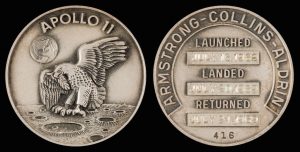
Apollo 11 flown silver Robbins Medal once owned by Wally Schirra
This medal was sold for $33,460.00 on April 18, 2013 by Heritage Auctions.
In March, before the Apollo 11 launch, President Dwight Eisenhower died of congestive heart failure at the age of 78. To honor the late president, congress passed the bill to produce what ended up to be the last large dollar coin with the portrait of Eisenhower. It was Rep. Bob Casey (D-TX) who remembered that Eisenhower created NASA and proposed that the reverse of the coin use the Apollo 11 mission insignia rather than just a heraldic eagle.
The Eisenhower dollar was released in 1971 and struck until 1978. Other than relief and varieties, the only design change was made in honor of the nation’s bicentennial in 1975-76.
-
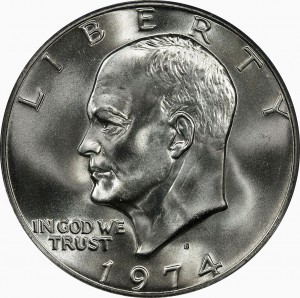
-
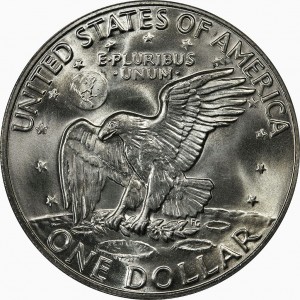
-
Eisenhower Dollar Reverse featuring the Apollo 11 mission insignia
Beginning in 1976, the U.S. Mint was looking to reduce the costs of coin production and was testing different shapes and compositions for a new dollar coin. In order to appease the powerful vending machine industry, the result was a coin that was too similar in size and composition to the quarter dollar. Congress made the decision to honor Susan B. Anthony and leave the Apollo 11 mission insignia on the reverse.
-
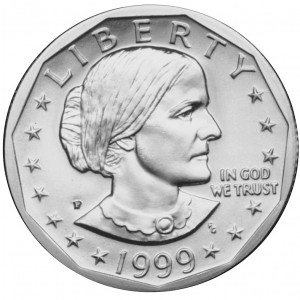
-
Susan B. Anthony dollar
-
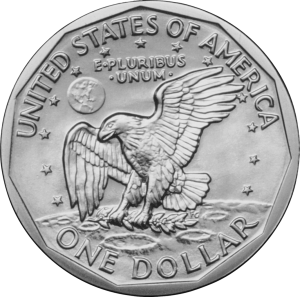
-
Reverse of the Susan B. Anthony dollar featuring the Apollo 11 mission insignia
Chief Engraver Frank Gasparro designed the reverse for both the Eisenhower and SBA dollars using the Apollo 11 mission insignia. An iconic design even though the coins were less than successful.
Credits
- Apollo mission insignia courtesy of NASA.
- Apollo 11 flown Robbins Medal courtesy of Heritage Auctions
- Coin images courtesy of the U.S. Mint.
Jul 4, 2016 | celebration, history
After nearly a year of war and attempted negotiation with King George III and the British parliament, it became clear that the colonies in the New World would continue to be under harsh rule without representation. In January 1776, the Continental Congress met to discuss the matter.
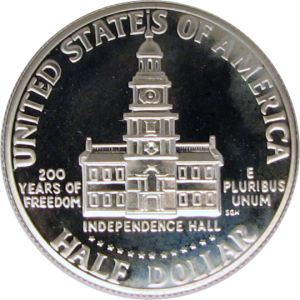 Public support for independence from the British Empire was growing amongst the colonies. Only the “middle colonies” of New York, New Jersey, Delaware, and Maryland who were benefiting financially being part of the British Empire were against independence. When these colonies sent delegations to the Continental Congress, each of their conventions did not allow them to vote for independence.
Public support for independence from the British Empire was growing amongst the colonies. Only the “middle colonies” of New York, New Jersey, Delaware, and Maryland who were benefiting financially being part of the British Empire were against independence. When these colonies sent delegations to the Continental Congress, each of their conventions did not allow them to vote for independence.
As the war with Great Britain dragged on and the attempt at tightening their reigns on the colonies persisted, the populous cry for independence grew. Delegates were set back to their governments and representatives sent to the middle colonies to convince them that the colonies had to declare independence for their own survival. As colonies began to line up with the independence movement, Pennsylvania, New York, Maryland, and South Carolina remained reticent on the subject.
Of the four hold outs, Pennsylvania and Maryland had governments with strong ties to the colonial governors who still had influence. John Adams wrote a draft preamble to explain the independence resolution. Part of the way the resolution was written was, in effect, to overthrow the colonial governments of Pennsylvania and Maryland so that it would be replaced by a popular government. On May 15, 1776, that preamble was passed. The colonies had taken their first step toward independence.
Delegates left the congress and returned to their own colonial conventions. Maryland, whose delegates walked out of the congress in protest, continued to reject the notion of independence. Samuel Chase returned to Maryland and convinced them to allow their delegates to approve the motion of independence. Pennsylvania, New York, and South Carolina remained against the declaration while the Delaware delegates were split.
On June 11, 1776, the “Committee of Five” was appointed to draft a declaration. Committee members were John Adams of Massachusetts, Benjamin Franklin of Pennsylvania, Thomas Jefferson of Virginia, Robert R. Livingston of New York, and Roger Sherman of Connecticut. Although no minutes were kept from the committee meetings, it was accepted that the resulting document was largely Jefferson’s work. The Committee of Five completed the draft on June 28, 1776.
-

-
Robert R. Livingston
-
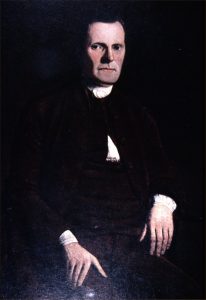
-
Roger Sherman
Debate on the draft declaration began on July 1. After a long day of speeches a vote was taken. Maryland voted yes but Pennsylvania and South Carolina voted no. The New York delegation abstained with out authority from their government to vote. Delaware could not vote because its delegate was split on the question. Edward Rutledge of South Carolina moved to postpone the vote until the next day.
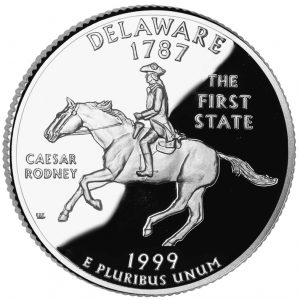 Although there is no written history on what happened that evening, there had to have been lobbying by supporters of independence because on July 2, South Carolina voted yes followed by a turnaround by the Pennsylvania delegation that also voted yes. New York with no authority from their government continued to abstain. With the Delaware delegation deadlocked, this set up the historical ride of Caesar Rodney. Rodney was one of Delaware’s representative to the Continental Congress. He was in Dover attending to other business when he learned that Thomas McKean and George Read were deadlocked on the vote of independence. Rodney rode 80 miles from Dover to Philadelphia to vote with McKean to allow Delaware join eleven other colonies voting in favor of independence.
Although there is no written history on what happened that evening, there had to have been lobbying by supporters of independence because on July 2, South Carolina voted yes followed by a turnaround by the Pennsylvania delegation that also voted yes. New York with no authority from their government continued to abstain. With the Delaware delegation deadlocked, this set up the historical ride of Caesar Rodney. Rodney was one of Delaware’s representative to the Continental Congress. He was in Dover attending to other business when he learned that Thomas McKean and George Read were deadlocked on the vote of independence. Rodney rode 80 miles from Dover to Philadelphia to vote with McKean to allow Delaware join eleven other colonies voting in favor of independence.
With 12 votes for independence and one abstention, the Continental Congress approved the declaration. Jefferson then set forth to make the agreed upon corrections to the document. On July 4, 1776, the Continental Congress approved the wording of the Declaration of Independence. The document was sent to the printer for publication and distribution to the public.
Although historians debate exactly when the final document was signed, it is accepted that the final signatures were added on August 2, 1776. Since New York approved the resolution of independence on July 10, the New York delegation is included amongst the signatures.
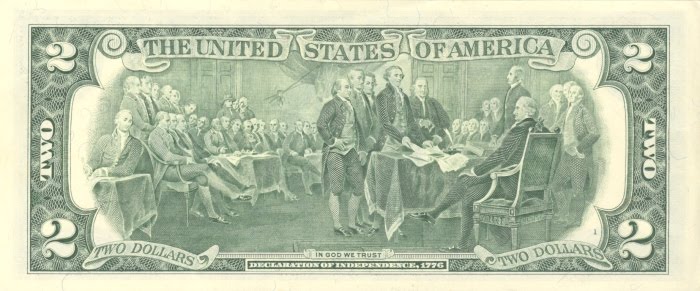

As we celebrate the 240th Birthday of the United States of America, please take a moment to remember those who fought for our freedom and continue to do so today. Honoring them is the best way to honor those whose vision created this great nation.
Credits
- “Declaration of Independence” by John Trumbull hangs in the U.S. Capitol Rotunda and was used as the model for the reverse of the $2 Federal Reserve Note. Image courtesy of Wikipedia.
- Bicentennial half-dollar reverse and Franklin half-dollar images courtesy of the author.
- All other coin images courtesy of the U.S. Mint
- All other images courtesy of Wikipedia.
May 12, 2016 | celebration, coins, nickels, video
If you missed the news, a few days ago President Barak Obama signed the National Bison Legacy Act (Pub. L. 114-152) that names the “North American Bison” the national mammal. The bison does not replace the Bald Eagle as the national animal or the national emblem.
The bison is an iconic animal unique to North America. Discovered by the European settlers as the country expanded west, the bison was significant to the economic and spiritual lives of the native tribes throughout the Great Plains areas.

Photo from the 1870s of a pile of American bison skulls waiting to be ground for fertilizer.
Although conservation efforts began in the late 19th century, a bison population that used to number in the millions the 2012 Department of Agriculture census said that there were 162,110 heads. Up until the last 50 years, we have done a bad job of taking care of this national resource, now national treasure.
When numismatist thinks of the American Bison, the thought turns to the Indian Head “ Buffalo” Nickel designed by James Earle Fraser. Fraser, a student of Augustus Saint-Gaudens, continued the path of Theodore Roosevelt’s “pet crime” to design a coin that screams America.
The reverse of the coin is an American Bison that we erroneous call a buffalo. According to legend, Black Diamond was Fraser’s model for the reverse of the Buffalo nickel. Black Diamond was a North American bison that was living in the Central Park Zoo. He was donated to the zoo by Barnum and Bailey and lived his life there until he was auctioned in 1915 to a game and poultry dealer who was later sold as steaks for $2 a pound.
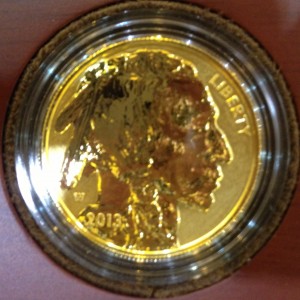
2013-W American Buffalo gold reverse proof obverse
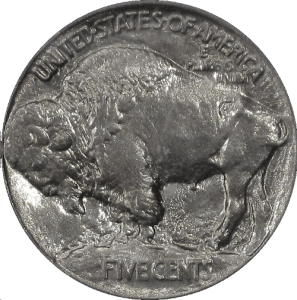
1913 Buffalo Nickel Type 1 Reverse
When asked about the model for the coin, Fraser said it was Black Diamond and found him in the Bronx Zoo. At one time Fraser was not sure of the name of the animal but insisted his influence was at the Bronx Zoo. Black Diamond was never at the Bronx Zoo. But like the story of who was the model for the Indian on the obverse, why should facts spoil a good story!
With the signing of the National Bison Legacy Act there are groups that wants to bring back the Buffalo nickel. Someone started a petition at the online petition website Change.org to convince the U.S. Mint to return to bring back the buffalo nickel.
Even though the U.S. Mint is the wrong agency to address this petition to since it would require an act of congress, the Fraser Buffalo design is still used on the 24-karat gold bullion coin. In fact, not counting varieties, mintmarks and strike types, the bison has appeared on eight different coins and one Legal Tender Note. If you want to put together a nice type set, it would require 22 different coins and the 1901 $10 Legal Tender Note (see “Collecting a Herd of Buffaloes” for this discussion).
I do not know if returning the Buffalo nickel is a good idea. While it was an iconic design, it was one that saw considerable wearing while in circulation. If someone wants to bring the buffalo back to United States coins, maybe we could consider the 2005 Westward Journey nickel with the American Bison reverse. It also has a better portrait of Thomas Jefferson than is currently used.
If you would like to virtually sign the partition, visit Change.org and register your vote.
The Washington Post produced an interesting video with facts about the bison. If you want to see the video without visiting the Post’s website, you can watch it here:
Bison images and the Type 1 Buffalo nickel reverse courtesy of Wikipedia.





















 As we do every month, we look back at the previous month’s activity in congress that will affect us numismatically. July started with congress on their 4th of July break coming back for a one week session before leaving to attend their respective conventions.
As we do every month, we look back at the previous month’s activity in congress that will affect us numismatically. July started with congress on their 4th of July break coming back for a one week session before leaving to attend their respective conventions.






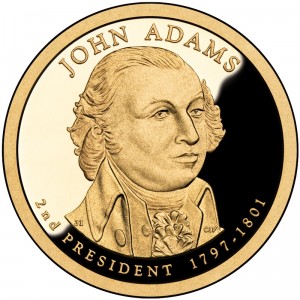
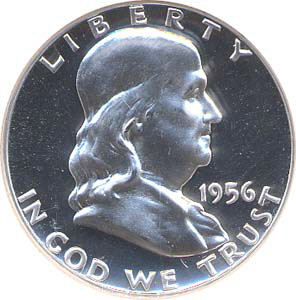



 Although there is no written history on what happened that evening, there had to have been lobbying by supporters of independence because on July 2, South Carolina voted yes followed by a turnaround by the Pennsylvania delegation that also voted yes. New York with no authority from their government continued to abstain. With the Delaware delegation deadlocked, this set up the historical ride of
Although there is no written history on what happened that evening, there had to have been lobbying by supporters of independence because on July 2, South Carolina voted yes followed by a turnaround by the Pennsylvania delegation that also voted yes. New York with no authority from their government continued to abstain. With the Delaware delegation deadlocked, this set up the historical ride of 




